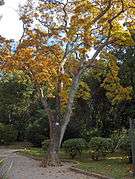Magnolia denudata
| Yulan magnolia |
| |
|
| Scientific classification |
| Kingdom: |
Plantae |
| (unranked): |
Angiosperms |
| (unranked): |
Magnoliids |
| Order: |
Magnoliales |
| Family: |
Magnoliaceae |
| Genus: |
Magnolia |
| Subgenus: |
M. subg. Yulania |
| Section: |
M. sect. Yulania subsect. Yulania |
| Species: |
M. denudata |
| Binomial name |
Magnolia denudata
Desr. |
|
| Synonyms[1] |
- Gwillimia yulan (Desf.) Kostel.
- Lassonia heptapeta Buc'hoz
- Magnolia alexandrina Steud.
- Magnolia citriodora Steud.
- Magnolia conspicua Salisb.
- Magnolia cyathiformis Rinz ex K.Koch
- Magnolia heptapeta (Buc'hoz) Dandy
- Magnolia precia Corrêa ex Vent. nom. inval.
- Magnolia spectabilis G.Nicholson nom. inval.
- Magnolia superba G.Nicholson nom. inval.
- Magnolia triumphans G.Nicholson nom. inval.
- Magnolia yulan Desf.
- Michelia yulan (Desf.) Kostel.
- Yulania conspicua (Salisb.) Spach
- Yulania cuneatifolia T.B.Chao, Zhi X.Chen & D.L.Fu
- Yulania denudata (Desr.) D.L.Fu
- Yulania pyriformis (T.D.Yang & T.C.Cui) D.L.Fu
|
Magnolia denudata, known as the lilytree[2] or Yulan magnolia (simplified Chinese: 玉兰花; traditional Chinese: 玉蘭花; pinyin: yùlánhuā; literally: "jade orchid/lily"), is native to central and eastern China.[3] It has been cultivated in Chinese Buddhist temple gardens since 600 AD. Its flowers were regarded as a symbol of purity in the Tang Dynasty and it was planted in the grounds of the Emperor's palace. It is the official city flower of Shanghai.
Description
Magnolia denudata is a rather low, rounded, thickly branched, and coarse-textured tree to 30 feet (9.1 m) tall. The leaves are ovate, bright green, 15 cm long and 8 cm wide. The bark is a coarse, dark gray. The 10–16 cm white flowers that emerge from early to late spring, while beautiful and thick with a citrus-lemon fragrance, are prone to browning if subjected to frost.
| View of mature Magnolia denudata - Botanical Park, Opatija, Croatia |
|
Cultivation
This plant is used as an ornamental tree in gardens. It is similar to other magnolias in that it likes rich, moist soil and should be planted in a location where it is protected from elemental extremes.
References
Further reading
- Russell, Tony & Catherine Cutler (Hermes House 2004) Trees, an Illustrated Identifier and Encyclopedia Aness Publishing.
External links

